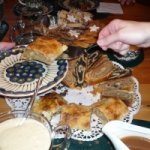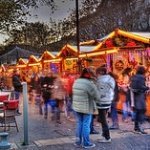|
German Christmas Traditions
|

|

|

|
Advent
For most Germans, the real Christmas season begins with the start of Advent, officially on the fourth Sunday before Christmas. During this time, German families and communities prepare for the arrival of Christ’s birth. On the first Sunday of Advent, families would traditionally gather around an Advent Wreath or Adventskranz and light the first of four candles (one for each week).
The increasingly elaborate Advent Calendar is also an important part of the season. Originally very simple with seasonal images revealed behind each window, they later were constructed to hold chocolate or other treats and are now even available with toys and puzzles. Children, and many adults, look forward to the daily treats, pictures, or messages to be found behind the day’s tiny window.
Christmas Markets
Of course, towns and cities throughout Germany and Austria mark the start of Advent with the opening of the public Christmas Market (Weihnachtsmarkt or Christkindlmarkt) toward the end of November. Although originally meant as a way to bring craftsmen and artisans together to sell their wares to townspeople, the modern versions are more festive destinations featuring a wide variety of products and, most importantly, the wonderful seasonal food and drink to be consumed by shoppers while browsing through stalls of handmade gifts and decorations.
Punsch (Rum Punch) and Gluhwein (Mulled Wine) are readily available to warm shoppers inside and out, while a wide variety of warm dishes and snacks are also served from numerous stalls. It has become a tradition at many Christmas Markets to issue special souvenir mugs in which they serve hot drinks. Shoppers can often choose to keep these mugs of return them for a deposit.
Visiting these wonderfully festive holiday markets is perhaps my favorite of all German Christmas traditions.
The Christmas Tree
Perhaps the most widespread and recognizable of German Christmas traditions it the use of a Christmas tree or Weihnachtsbaum. Elaborately lighted and decorated evergreens are a staple in hotels, shopping malls, and office buildings around the world throughout the Christmas season. While in other parts of the world, trees start to go up even as early as late November, tradition in Germany still calls for the trees to be modestly trimmed and lit with real candles only on the 24th of December. Although the idea of real candles on the tree can give Americans four-alarm nightmares, it is important to remember that the tree is usually a live, potted pine, moved inside just before the lighting. Real candles would not be wise on a month old, cut tree that is likely as dry as a bone. It is also important to note that a German tree is lit only when the family is gathered around it to exchange gifts on the evening of December 24th, and not all day and night as some electrically lit trees are.
Christmas Sweets
Every German sweet tooth looks forward to the Advent and Christmas season with salivating expectation. The list of sweet treats that are prepared almost exclusively around Christmas is a long one. From Stollen, Strudel, and Lebkuchen, to the wide variety of German Christmas cookies, the array of delicious Christmas baked goods is astounding. I would say that the German kitchen could be largely responsible for that extra holiday weight we all pledge to shed come January.
From German Christmas Traditions
Back to German Recipes Homepage

